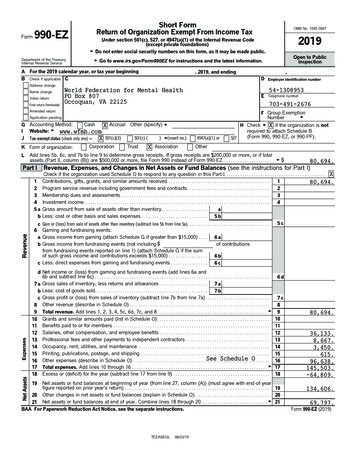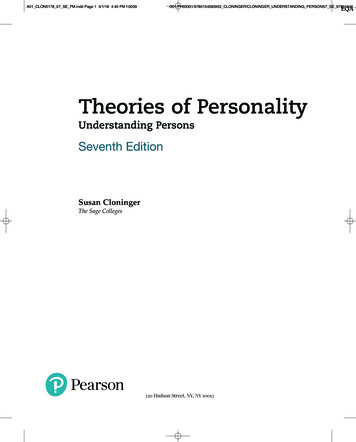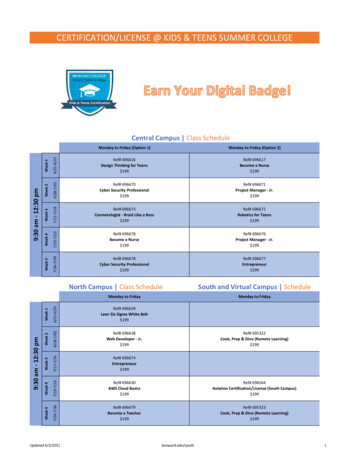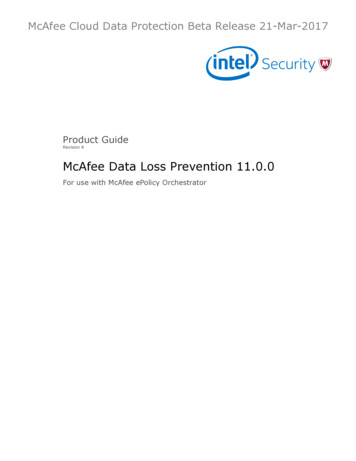
Transcription
Instructions for Petition for Nonimmigrant WorkerDepartment of Homeland SecurityU.S. Citizenship and Immigration ServicesTable of ContentsUSCISForm I-129OMB No. 1615-0009Expires 07/31/2022PageInstructions for Form I-129General InformationThe Purpose of Form I-129.2Who May File Form I-129?.3General Filing Instructions.3Classification-Initial Evidence.6Part 1. Petition Always RequiredE-2 CNMI Classification.7H Classifications.7H-1B Data Collection.9L Classification.16O and P Classifications.17Q-1 Classification.21R-1 Classification.21Part 2. Petition Only Required for an Alien in the United States to Change Status or Extend StayE Classifications (not including E-2 CNMI).22Free Trade Nonimmigrant Classifications (H-1B1 and TNs).24Filing RequirementsWritten Consultation for O and P Nonimmigrants.25What Is the Filing Fee?.26When To File?.27Where To File?.27Additional InformationProcessing Information.28USCIS Forms and Information.28USCIS Privacy Act Statement.29USCIS Compliance Review and Monitoring.29Paperwork Reduction Act.30Supplements to Form I-129E-1/E-2 Classification Supplement.9Trade Agreement Supplement. 11H Classification Supplement.13H-1B Data Collection and Filing Fee Exemption Supplement.19L Classification Supplement.22O and P Classifications Supplement.26Q-1 Classification Supplement.29R-1 Classification Supplement.30Attachment - 1 (Used when more than one alien is included on the form).35Form I-129 Instructions05/31/22Page 1 of 30
The Purpose of Form I-129This form is used by an employer to petition U.S. Citizenship and Immigration Services (USCIS) for an alien beneficiaryto come temporarily to the United States as a nonimmigrant to perform services or labor, or to receive training.Form I-129 consists of the:1. Basic petition;2. Individual supplements relating to specific classifications; and3. H-1B Data Collection and Filing Fee Exemption Supplement (required for H-1B and H-1B1 classifications only).These instructions are divided into two parts:Part 1: Classifications that always require a petition.E-2 CNMI -- treaty investor exclusively in the Commonwealth of the Northern Mariana Islands (CNMI).H-1B -- specialty occupation worker; an alien coming to perform services of an exceptional nature that relate to aU.S. Department of Defense-administered project; or a fashion model of distinguished merit and ability.H-2A -- temporary agricultural worker.H-2B -- temporary nonagricultural worker.H-3 -- trainee.L-1 -- intracompany transferee.O-1 -- alien of extraordinary ability in arts, science, education, business, or athletics.O-2 -- accompanying alien who is coming to the United States to assist in the artistic or athletic performance of anO-1 artist or athlete.P-1 -- major league sports.P-1 -- internationally recognized athlete/entertainment group.P-1S -- essential support personnel for a P-1.P-2 -- artist/entertainer in reciprocal exchange program.P-2S -- essential support personnel for a P-2.P-3 -- artist/entertainer coming to the United States to perform, teach, or coach under a program that is culturallyunique.P-3S -- essential support personnel for a P-3.Q-1 -- alien coming temporarily to participate in an international cultural exchange program.R-1 -- religious worker.Part 2: Classifications that require a petition only if the beneficiary is already in the United States and requesting anextension of stay or a change of status:E-1 -- treaty trader.E-2 -- treaty investor (not including E-2 CNMI treaty investors).E-3 -- Free Trade Agreement professionals from Australia.Free Trade Nonimmigrants -- H-1B1 specialty occupation workers from Chile or Singapore and TN professionalsfrom Canada or Mexico.Form I-129 Instructions05/31/22Page 2 of 30
Who May File Form I-129?General. A U.S. employer may file this form and applicable supplements to classify an alien in any nonimmigrantclassification listed in Part 1. or Part 2. of these instructions. A foreign employer, U.S. agent, or association of U.S.agricultural employers may file for certain classifications as indicated in the specific instructions.Agents. A U.S. individual or company in business as an agent may file a petition for workers who are traditionallyself-employed or workers who use agents to arrange short-term employment on their behalf with numerous employers,and in cases where a foreign employer authorizes the agent to act on its behalf. A petition filed by an agent must includea complete itinerary of services or engagements, including dates, names, and addresses of the actual employers, and thelocations where the services will be performed. A petition filed by a U.S. agent must guarantee the wages and other termsand conditions of employment by contractual agreement with the beneficiary or beneficiaries of the petition. The agent/employer must also provide an itinerary of definite employment and information on any other services planned for theperiod of time requested.Including more than one alien in a petition. You may include on the same petition multiple aliens who seek admissionin the H-2A, H-2B, H-3, P-1, P-2, P-3, P-1S, P-2S, P-3S, O-2, or Q-1 classifications provided all will:1. Be employed for the same period of time; and2. Perform the same services, receive the same training, or participate in the same international cultural exchangeprogram.NOTE: Employers must file a separate Form I-129 to petition for O and P essential support personnel apart from anypetition they file for O or P principal aliens or P group or team. All essential-support beneficiaries listed on this petitionmust establish prior essentiality to the principal O or P aliens.Exception: It is recommended that H-2A and H-2B petitions for workers from countries not listed on the respective“Eligible Countries List” be filed separately. See www.uscis.gov for the list of H-2A and H-2B participating countries.Multiple locations. A petition for aliens to perform services or labor or receive training in more than one location mustinclude an itinerary with the dates and locations where the services or training will take place.Naming beneficiaries. Allbeneficiaries in a petition must be named except for an H-2A agricultural worker or an H-2Btemporary nonagricultural worker.Exceptions for H-2A/H-2B temporary workers: You must provide the name, date of birth, country of birth, and countryof nationality of all H-2A and H-2B workers when (1) the petition is filed for a worker who is a national of a countrynot designated by the Secretary of Homeland Security as eligible to participate in the H-2A or H-2B program; or (2) thebeneficiary is in the United States. In addition, USCIS may require the petitioner to name H-2B beneficiaries where thename is needed to establish eligibility for H-2B nonimmigrant status.Where some or all of the beneficiaries are not named, specify the total number of unnamed beneficiaries and total numberof beneficiaries in the petition.General Filing InstructionsUSCIS provides forms free of charge through the USCIS website. In order to view, print, or fill out our forms, you shoulduse the latest version of Adobe Reader, which can be downloaded for free at http://get.adobe.com/reader/.Each petition must be properly signed and filed. For all signatures on this application, USCIS will not accept a stamped ortypewritten name in place of a handwritten signature.Each petition must be accompanied by the appropriate filing fees. (See the What Is the Filing Fee section of theseinstructions.)Evidence. You must submit all required initial evidence along with all the supporting documentation with your petition atthe time of filing.Form I-129 Instructions05/31/22Page 3 of 30
Biometrics Services Appointment for Certain Beneficiaries Who Will be Working in the CNMI. After receiving yourpetition and ensuring completeness, USCIS will inform you in writing when the beneficiary needs to go to his/her localUSCIS Application Support Center (ASC) for his/her biometrics services appointment. Failure to attend the biometricsservices appointment may result in denial of your petition.Form I-94, Arrival - Departure Record. If U.S. Customs and Border Protection (CBP) or USCIS issued the beneficiarya Form I-94, Arrival-Departure Record, provide his/her I-94 admission number and date that his/her authorized period ofstay expires or expired (as shown on the Form I-94). The I-94 admission number also is known as the Departure Numberon some versions of Form I-94.NOTE: If the beneficiary was admitted to the United States by CBP at an airport or seaport after April 30, 2013, he/shemay have been issued an electronic Form I-94 by CBP, instead of a paper Form I-94. He/she may visit the CBP website atwww.cbp.gov/I94 to obtain a paper version of the electronic Form I-94. CBP does not charge a fee for this service. Sometravelers admitted to the United States at a land border, or air or sea port, after April 30, 2013 with a passport or traveldocument, who were issued a paper Form I-94 by CBP, may also be able to obtain a replacement Form I-94 for the CBPwebsite without charge. If Form I-94 cannot be obtained from the CBP website, it may be obtained by filing Form I-102,Application for Replacement/Initial Nonimmigrant Arrival-Departure Document, with USCIS. USCIS does charge a feefor this service. Form I-102 may be filed together with this Form I-129.Copies. You may submit a legible photocopy of any document requested, unless the instructions specifically state thatyou must submit an original document. Original documents submitted when not required may remain a part of the record,and will not be automatically returned to you.Translations. Any document you submit to USCIS information in a foreign language must have a full English languagetranslation. The translator must certify that the English language translation is complete and accurate, and that he or she iscompetent to translate from the foreign language into English.How to Fill Out Form I-1291. Type or print legibly in black ink.2. Complete the basic form and any relating supplements.3. If you need extra space to complete any item, go to Part 9., Additional Information About Your Petition forNonimmigrant Worker, indicate the Page Number, Part Number, and Item Number to which your answer refers,and date and sign each sheet.4. Answer all questions fully and accurately. If an item is not applicable or the answer is “none,” type or print “N/A”.5. Submit a duplicate copy of the petition and all supporting documentation. Failure to do so may result in delays inprocessing this petition or in visa processing abroad.Petitioner InformationComplete the “Legal Name of Petitioner” field (if the petitioner is an individual person or a company or organization).For mailing address, list the address of the petitioner’s primary office within the United States. This address willdetermine the filing jurisdiction if the beneficiary will be providing services or completing training in multiple locations.Basis for ClassificationThe following explains the choices listed in Part 2., Item Number 2., of the Form I-129.A. New employment. Check this box if the beneficiary:(1) Is outside the United States and holds no classification;(2) Will begin employment for a new U.S. employer in a different nonimmigrant classification than the beneficiarycurrently holds; or(3) Will work for the same employer but in a different nonimmigrant classification.NOTE: Do not check this box if the beneficiary will work for the same employer in the same classification butthere is a material change in the terms and conditions of employment, training, or the beneficiary’s eligibility asspecified in the original approved petition. Check the box for Item f., Amended Petition, instead.Form I-129 Instructions05/31/22Page 4 of 30
B. Continuation of previously approved employment without change with the same employer. Check this boxif you are applying to continue the employment of the beneficiary in the same nonimmigrant classification thebeneficiary currently holds and there has been no change to the employment.C. Change in previously approved employment. Check this box if you are notifying USCIS of a non-material changeto the previously approved employment such as a change in job title without a material change in job duties.D. New concurrent employment. Check this box if you are applying for a beneficiary to begin new employmentwith an additional employer in the same nonimmigrant classification the beneficiary currently holds while thebeneficiary will continue working for his or her current employer in the same classification.E. Change of employer. Check this box if you are applying for a beneficiary to begin employment working for anew employer in the same nonimmigrant classification that the beneficiary currently holds.F. Amended petition. Check this box if you are applying to notify USCIS of a material change in the terms orconditions of employment or training or the beneficiary’s eligibility as specified in the original approved petition.Additionally, petitioners requesting H-2A or H-2B substitutions should check this box.Requested ActionThe following explains the kinds of action petitioners/employers may choose for Part 2., Information About ThisPetitioner, Item Number 4. of Form I-129. Choose only one action.A. Notify the office listed in Part 4. so the beneficiary(ies) can seek a visa or admission. Check this box if thebeneficiary is outside of the United States, or, if the beneficiary is currently in the United States, but he or she willleave the United States to obtain a visa/admission abroad.B. Change the status and extend the stay of beneficiaries who are now in the United States in another status.Check this box if the beneficiary is currently in the United States in a different nonimmigrant classification and isapplying to change to a new, nonimmigrant status.Exception: If the beneficiary seeks to change status to H-1B1 Chile/Singapore or TN classification, see Item f.below.C. Extend the stay of each beneficiary who now holds this status. Check this box if the beneficiary is currentlyin the United States in a nonimmigrant classification and is requesting an extension of his or her stay in the samenonimmigrant classification.Exception: If the beneficiary seeks to extend his/her stay in H1B1 Chile/Singapore or TN classification, seeItem e. below.D. Amend the stay of each beneficiary who now holds this status. Check this box if the beneficiary is currently inthe United States in the same nonimmigrant classification and you are notifying USCIS of any material changesin the terms and conditions of employment, training or the beneficiary’s eligibility as specified in the originalapproved petition.E. Extend the status of a nonimmigrant classification that is based on a Free Trade Agreement. Check this boxif the beneficiary is currently in the United States based on a Free Trade Agreement (H-1B1 Chile/Singapore orTN classification) and is requesting an extension of his or her stay in that same classification.F. Change status to a nonimmigrant classification that is based on a Free Trade Agreement. Check this boxif the beneficiary is currently in the United States in a different nonimmigrant classification and is applyingto change to a nonimmigrant classification based on a Free Trade Agreement (H-1B1 Chile/Singapore or TNclassification).Form I-129 Instructions05/31/22Page 5 of 30
Certification Pertaining to the Release of Controlled Technology or Technical Data to Foreign Persons in the UnitedStatesU.S. Export Controls on Release of Controlled Technology or Technical Data to Foreign Persons. The ExportAdministration Regulations (EAR) (15 CFR Parts 770-774) and the International Traffic in Arms Regulations (ITAR) (22CFR Parts 120-130) require U.S. persons to seek and receive authorization from the U.S. Government before releasing toforeign persons in the United States controlled technology or technical data. Under both the EAR and the ITAR, releaseof controlled technology or technical data to foreign persons in the United States--even by an employer--is deemed to bean export to that person’s country or countries of nationality. One implication of this rule is that a U.S. company mustseek and receive a license from the U.S. Government before it releases controlled technology or technical data to itsnonimmigrant workers employed as H-1B, H-1B1, L-1, or O-1A beneficiaries.Requirement to Certify Compliance with U.S. Export Control Regulations. The U.S. Government requires eachcompany or other entity that files a Form I-129 to certify that to the best of its knowledge at the time of filing it hasreviewed the Export Administration Regulations (EAR) and the International Traffic in Arms Regulations (ITAR) anddetermined whether it will require a U.S. Government export license to release controlled technology or technical data tothe beneficiary.If an export license is required, the company or other entity must further certify that it will not release or otherwiseprovide access to controlled technology or technical data to the beneficiary until it has received the required authorizationfrom the U.S. Government.The petitioner must indicate whether or not a license is required in Part 6., Certification Regarding the Release ofControlled Technology or Technical Data to Foreign Persons in the United States, of Form I-129.Controlled Technology and Technical Data. The licensing requirements described above will affect only a smallpercentage of petitioners because most types of technology are not controlled for export or release to foreign persons.The technology and technical data that are, however, controlled for release to foreign persons are identified on the EAR’sCommerce Control List (CCL) and the ITAR’s U.S. Munitions List (USML). The CCL is found at 15 CFF Part 774,Supp. 1. See http://www.access.gpo.gov/bis/ear/ear data.html#ccl. The USML is at 22 CFR 121.1. Seehttp://www.pmddtc.state.gov/regulations laws/itar.html. The EAR-controlled technology on the CCL generallypertains to that which is for the production, development, or use of what are generally known as “dual-use” items. TheITAR-controlled technical data on the USML generally pertains to that which is directly related to defense articles.The U.S. Department of Commerce’s Bureau of Industry and Security administers the CCL and is responsible forissuing licenses for the release to foreign persons of technology controlled under the EAR. The U.S. Department ofState’s Directorate of Defense Trade Controls (DDTC) administers the USML and is responsible for issuing licensesfor the release to foreign persons of technical data controlled under the ITAR. Information about the EAR and how toapply for a license from BIS are at www.bis.doc.gov. Specific information about EAR’s requirements pertaining to therelease of controlled technology to foreign persons is at xports.Information about the ITAR and how to apply for a license from DDTC are at www.pmddtc.state.gov.Classification - Initial EvidenceFor all classifications, if a beneficiary is seeking a change of status or extension of stay, evidence of maintenance ofstatus must be included with the new petition. If the beneficiary is employed in the United States, the petitioner maysubmit copies of the beneficiary’s last 2 pay stubs, Form W-2, and other relevant evidence, as well as a copy of thebeneficiary’s Form I-94, passport, travel document, or I-797.The beneficiary’s dependent family members (generally, spouses and children under 21) should use Form I-539,Application to Change/Extend Nonimmigrant Status, to apply for a change of status or extension of stay.A nonimmigrant, who must have a passport to be admitted, generally must maintain a valid passport during his or herentire stay.The following nonimmigrants are not eligible to change status:1. An alien admitted under a visa waiver program;2. An alien is transit (C) or in transit without a visa (TWOV);Form I-129 Instructions05/31/22Page 6 of 30
3. A crewman (D);4. A fiancé(e) (K-1) or his or her dependent (K-2);5. A spouse of a U.S. citizen (K-3) or his or her dependent (K-4);6. A J-1 exchange visitor who was admitted in J-1 status for the purpose of receiving graduate medical training;7. A J-1 exchange visitor subject to the foreign residence requirement who has not received a waiver of that requirement;and8. An M-1 student to an H classification, if training received as an M-1 helped him or her qualify for H classification.Part 1. Petition Always RequiredThe following classifications always require a petition.The initial evidence listed below and the initial evidence listed under the instructions for a change of status or extension ofstay must be included with a petition for a new or concurrent employment or for an extension where there is a change inpreviously approved employment.However, a petition for extension based on unchanged, previously approved employment should only be filed with theinitial evidence required in the extension of stay instructions.E-2 CNMIAn E-2 CNMI investor is an alien who seeks to enter or remain in the Commonwealth of the Northern MarianaIslands (CNMI) in order to maintain an investment in the CNMI that was approved by the CNMI governmentprior to November 28, 2009. An E-2 CNMI investor classification is specifically limited to an alien investor whohas previously been granted a qualifying long term investor status under the laws of the CNMI. This classificationallows an eligible alien to be lawfully present in the CNMI in order to maintain the investment during thetransition period from CNMI to Federal immigration law. An investor’s nationality is not a qualifying factor in theissuance of an E-2 CNMI investor classification.This classification expires on December 31, 2029A petition for the initial issuance of an E-2 CNMI investor classification must be filed within 2 years of the date the E-2CNMI investor classification became available, which was January 18, 2011. Petitions for the initial issuance of the E-2CNMI filed after January 18, 2013 will be rejected.Requests for extension of the E-2 CNMI investor classification may be granted, in increments of not more than 2 years,until December 31, 2029.Applications for the dependents of E-2 CNMI investors must be filed on Form I-539, Application to Extend/ChangeNonimmigrant Status.Write E-2C in the classification block.The petition must be filed with documentary evidence of:1. Continuous maintenance of the terms and conditions of E-2 CNMI investor nonimmigrant status;2. Physical presence in the CNMI at the time of filing of the extension of stay request; and3. The fact that the beneficiary will not leave during the pendency of the extension of stay request.H-1B Nonimmigrants (Three Types)The H-1B classification is for aliens coming to the United States temporarily to perform services in a specialtyoccupation.Write H-1B in the classification block.Form I-129 Instructions05/31/22Page 7 of 30
A specialty occupation is one that requires the theoretical and practical application of a body of highly specializedknowledge to fully perform the occupation and requires the attainment of a bachelor’s or higher degree in a specificspecialty, or its equivalent, as a minimum for entry into the occupation in the United States.The petition must be filed by a U.S. employer or a U.S. agent and must be filed with:1. Evidence that a labor condition application (LCA) has been certified by the U.S. Department of Labor;2. Evidence showing that the proposed employment qualifies as a specialty occupation;3. Evidence showing that the beneficiary has the required degree by submitting either:A. A copy of the beneficiary’s U.S. bachelor’s or higher degree as required by the specialty occupation;B. A copy of a foreign degree and evidence that it is equivalent to the U.S. degree; orC. Evidence of education, specialized training, and/or progressively responsible experience that is equivalent to therequired U.S. degree.4. A copy of any required license or other official permission to practice the occupation in the state of intendedemployment; and5. A copy of any written contract between the petitioner and the beneficiary or a summary of the terms of the oralagreement under which the beneficiary will be employed.6. If you are filing an H-1B cap petition for a fiscal year that H-1B registration is required, you must provide a validBeneficiary Confirmation Number for the beneficiary included in this petition, along with a copy of the H-1BRegistration Selection Notice.NOTE: This evidence requirement is not applicable to H-1B2 petitions.7. Off-site Assignment of H-1B Beneficiaries: Petitioners seeking to place the H-1B beneficiary off-site at a locationother than their own location must answer general questions regarding this assignment in Part 5., Basic InformationAbout the Proposed Employment and Employer. Petitioners should advise the H-1B beneficiary of the off-sitework placement.Additionally, petitioner should submit an itinerary that shows the dates and places of assignment if the beneficiary willbe providing services at more than one location.The H-1B classification is also for aliens coming to the United States to perform services of an exceptional naturerelating to a cooperative research and development project administered by the U.S. Department of Defense(DOD).Write H-1B2 in the classification requested block.A U.S. employer or U.S. agent may file the petition.The petition must be filed with:1. A description of the proposed employment;2. Evidence that the services and project meet the above conditions;3. A statement listing the names of aliens who are currently or have been employed on the project within the past year,along with their dates of employment;4. Evidence that the beneficiar
Form I-129 Instructions 05/31/22 Page 2 of 30. The Purpose of Form I-129. This form is used by an employer to petition U.S. Citizenship and Immigration Services (USCIS) for an alien beneficiary . to come temporarily to the United States as a nonimmigrant to perform services or labor, or to receive training. Form I-129 consists of the: 1. Basic .










